Biography
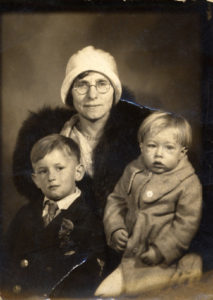
Andy Warhol, born Andrew Warhola on August 6, 1928, was the youngest of three sons born to Andrej Warhola and Julia Zavacky Warhola. His parents immigrated to the Unite
d States from the European region that is now Slovakia, settling into the working-class neighborhood of Uptown in Pittsburgh, Pennsylvania. Warhol graduated from Carnegie Institute of Technology (now Carnegie Mellon University) in Pittsburgh with a Bachelor of Fine Art in Pictorial Design in 1949 and soon after moved to New York City to pursue a career as a commercial artist.
Throughout the 1950s, he became one of the most successful illustrators of his time and won numerous awards for his work. His clients included Tiffany & Co., The New York Times, I. Miller Shoes, Bonwit Teller, Columbia Records, Fleming-Joffe, NBC, and others. Much of his commercial work was based on photographs and other source images, a process he would use for the rest of his life. While he continued to work as a commercial artist throughout his career, in the early 60s Warhol transitioned into the fine art world, gaining notoriety in the nascent Pop Art movement.
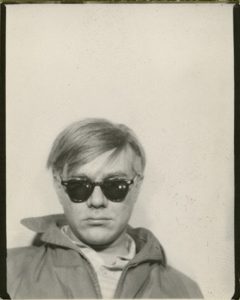 Early Pop paintings were based on comics and ads, with his series of Campbell’s Soup Cans in 1962 creating a buzz in the art world that launched Warhol as a celebrity. Other early subjects drew upon Warhol’s life-long fascination with Hollywood and sensationalism; in 1962 he began a large series of celebrity portraits, including Marilyn Monroe, Elvis Presley, and Elizabeth Taylor. He also produced a series of “death and disaster” paintings at this time – canvases included images of electric chairs, suicides, and car crashes.
Early Pop paintings were based on comics and ads, with his series of Campbell’s Soup Cans in 1962 creating a buzz in the art world that launched Warhol as a celebrity. Other early subjects drew upon Warhol’s life-long fascination with Hollywood and sensationalism; in 1962 he began a large series of celebrity portraits, including Marilyn Monroe, Elvis Presley, and Elizabeth Taylor. He also produced a series of “death and disaster” paintings at this time – canvases included images of electric chairs, suicides, and car crashes.
Throughout his career Warhol continually explored different mediums to create art. In 1963 he began to make films, and created many classics of avant-garde cinema, including Sleep (1963), Empire (1964), Kiss (1963-64), The Chelsea Girls (1966), and a body of work known as Screen Tests (4-minute portrait films, from 1964-1966). He broadened his activities into the realm of performance art with a traveling multimedia show called The Exploding Plastic Inevitable, which featured the rock and roll band The Velvet Underground.
Andy Warhol poses with a step guide.On June 3, 1968, Valerie Solanas, a writer who had appeared in Warhol’s film I, a Man (1967-68), came into the studio and shot Warhol in the chest, angered over a script she wrote and thought Warhol stole. In the year following his recovery he co-founded Interview, a magazine devoted to film, fashion, and popular culture that continues to this day. Interview testified to Warhol’s lifelong obsession with film stars and other contemporary celebrities.
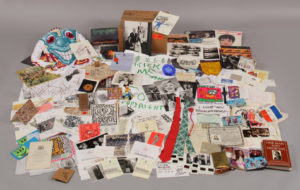 In 1974 Warhol started a series of Time Capsules, cardboard boxes that he filled with the materials of his everyday life, including mail, photos, art, clothing, collectibles, etc. The Time Capsules number over 600 boxes, providing an intimate and detailed look at the artist’s life and process.
In 1974 Warhol started a series of Time Capsules, cardboard boxes that he filled with the materials of his everyday life, including mail, photos, art, clothing, collectibles, etc. The Time Capsules number over 600 boxes, providing an intimate and detailed look at the artist’s life and process.
Warhol accepted commission work as early as 1963, but portrait commissions became a significant source of output and income as he mixed further with New York’s high society circles. Whether captured in photographs or paintings, Warhol’s work blurred the lines between artist, socialite, and celebrity with his 70s and 80s work, capturing the images of everyone from Liza Minnelli, Halston, Grace Jones, Mick Jagger, and many others.
In the mid-80s, Warhol collaborated on artworks with young artists including Jean-Michel Basquiat and Keith Haring. Warhol and Basquiat together produced over 150 collaborative canvases over a four-year period. In the mid-1980s his television shows, Andy Warhol’s TV and Andy Warhol’s Fifteen Minutes, aired on Madison Square Garden cable television and on MTV.
In addition to his many portrait commissions, from the 1970s onward, Warhol’s solo output continued producing a prolific number of paintings, prints, photographs, and drawings. Series including Mao, Ladies and Gentlemen, Skulls, Oxidation, and many others, culminating in his Last Supper paintings, which were shown in Milan in early 1987.
Warhol died in New York City on February 22, 1987, due to complications following surgery to remove his gall bladder. After Warhol’s death The Andy Warhol Foundation for the Visual Arts, Inc. was founded to promote the “advancement of visual arts.” The Andy Warhol Museum was announced in 1989 and opened in Pittsburgh in 1994.
Image Gallery
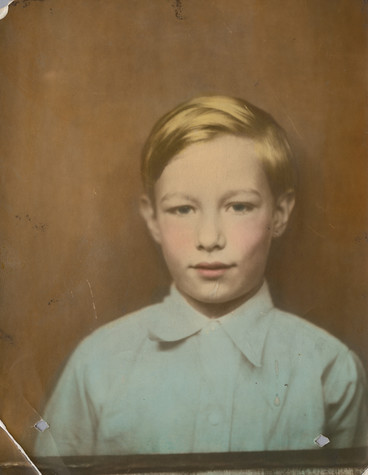
Unknown, Andy Warhol as a young boy, ca. 1936
The Andy Warhol Museum, Pittsburgh; Founding Collection, Contribution The Andy Warhol Foundation for the Visual Arts, Inc.
1998.3.5218
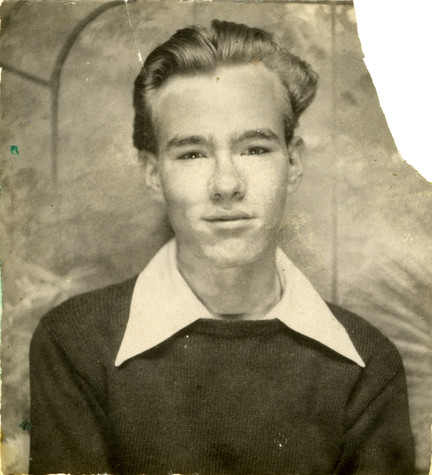
John Warhola, Andy Warhol on the day before he started college, photographed by his brother John in the photo studio that he operated with their cousin John Preksta, September 1945, 1945
The Andy Warhol Museum, Pittsburgh; Founding Collection, Contribution The Andy Warhol Foundation for the Visual Arts, Inc.
T600
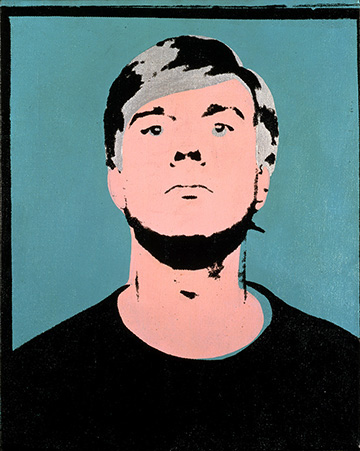
Andy Warhol, Self-Portrait, 1964, © The Andy Warhol Foundation for the Visual Arts, Inc.
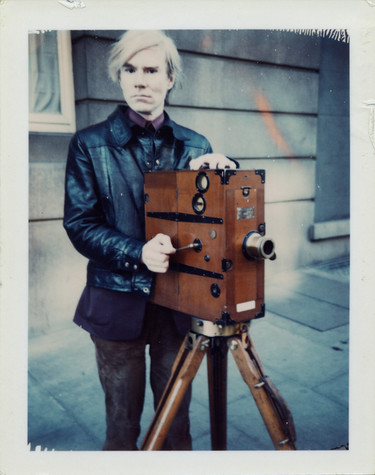
Andy Warhol, Self-Portrait with Movie Camera, ca. 1971
The Andy Warhol Museum, Pittsburgh; Founding Collection, Contribution The Andy Warhol Foundation for the Visual Arts, Inc.
© The Andy Warhol Foundation for the Visual Arts, Inc.
1998.3.8902
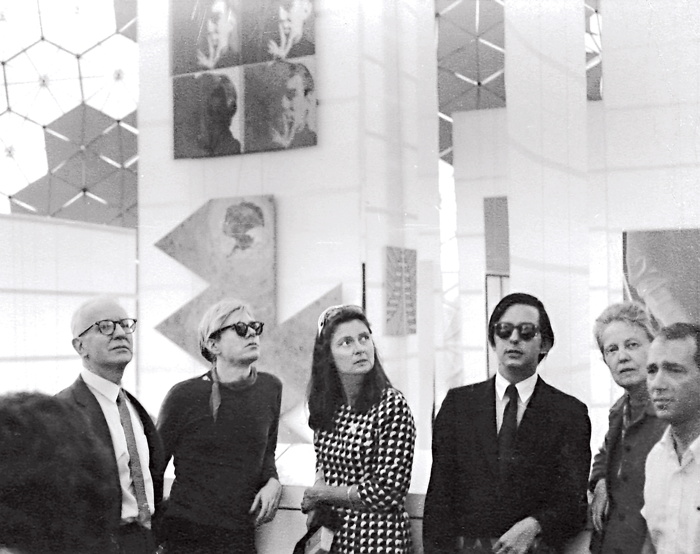
fig. 4 John de Menil, Andy Warhol, Simone Swan, Fred Hughes, Dominique de Menil, and Howard Barnstone inside the United States Pavilion at Expo 67 in Montreal. Warhol’s Self-Portrait, 1967, and Buckminster Fuller’s Dymaxion map are visible in the background.
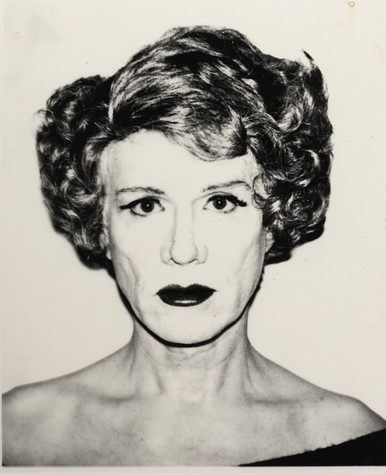
Andy Warhol, Small Acetate (Self-Portrait in Drag), 1980
The Andy Warhol Museum, Pittsburgh; Founding Collection, Contribution The Andy Warhol Foundation for the Visual Arts, Inc.
© The Andy Warhol Foundation for the Visual Arts, Inc.
1998.3.1135.1a
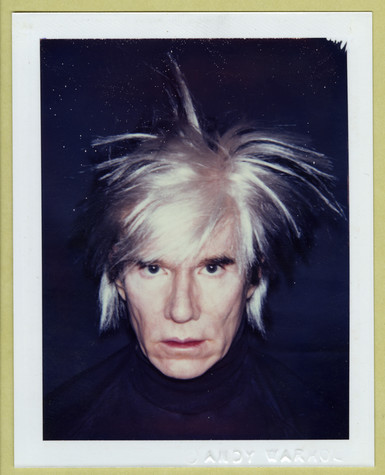
Andy Warhol, Self-Portrait (Fright Wig), 1986
The Andy Warhol Museum, Pittsburgh; Founding Collection, Contribution The Andy Warhol Foundation for the Visual Arts, Inc.
1998.1.2900
If you want to know all about Andy Warhol, just look at the surface of my paintings and films and me, and there I am. There’s nothing behind it.

